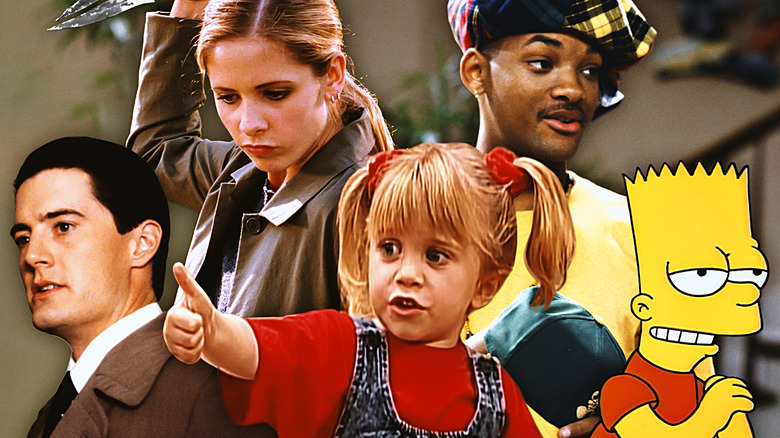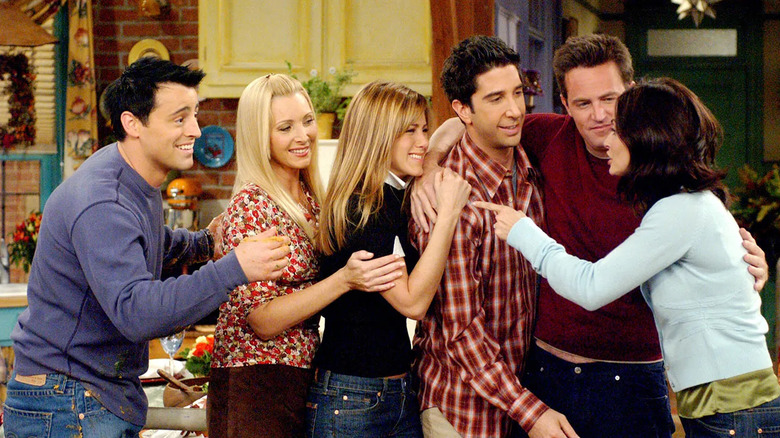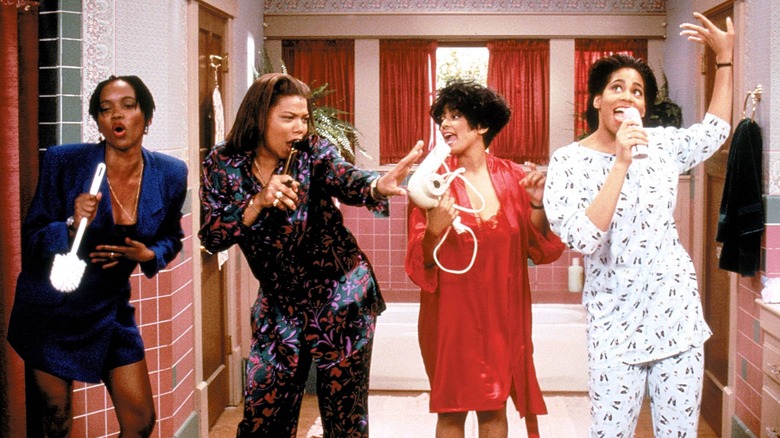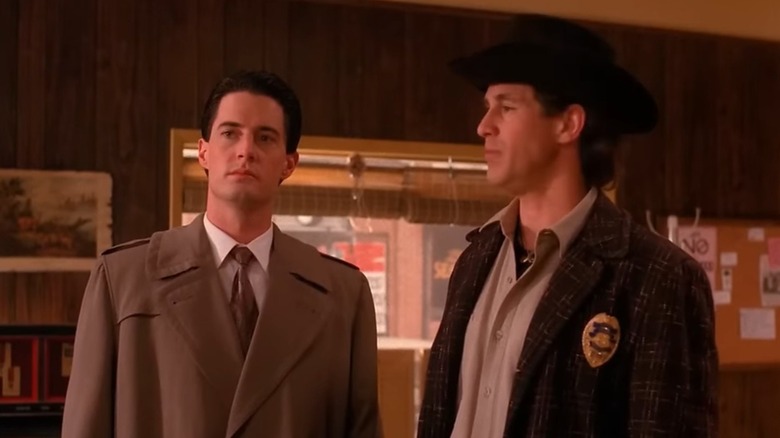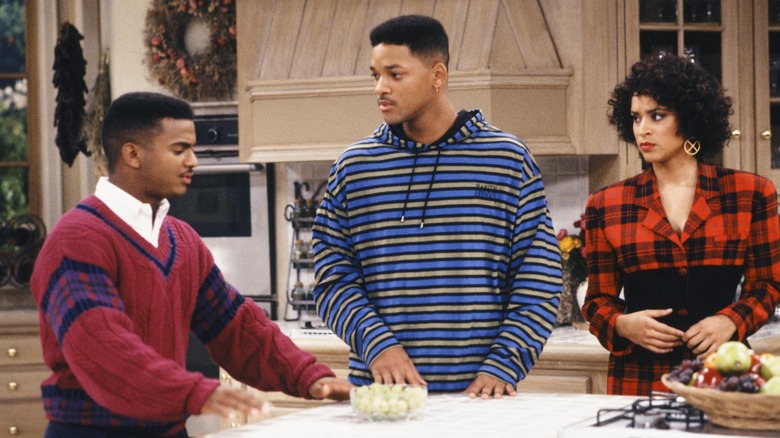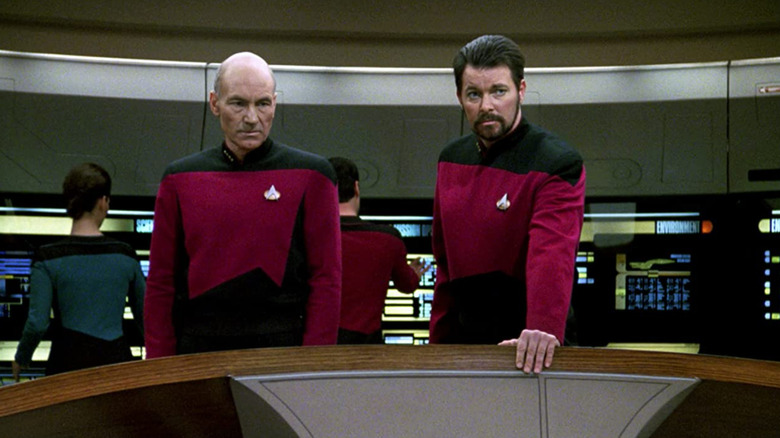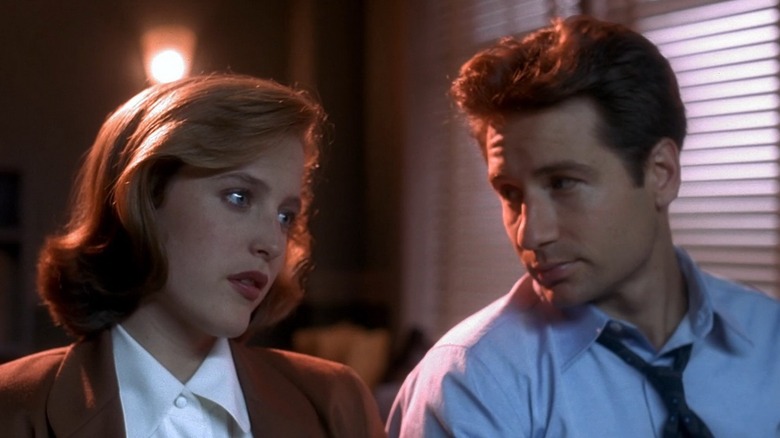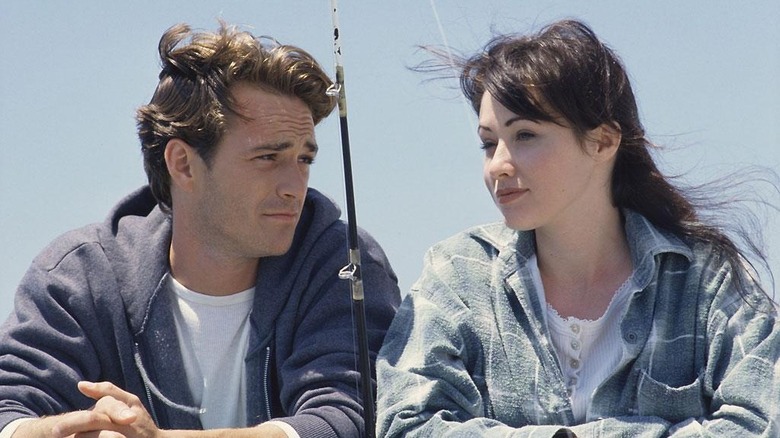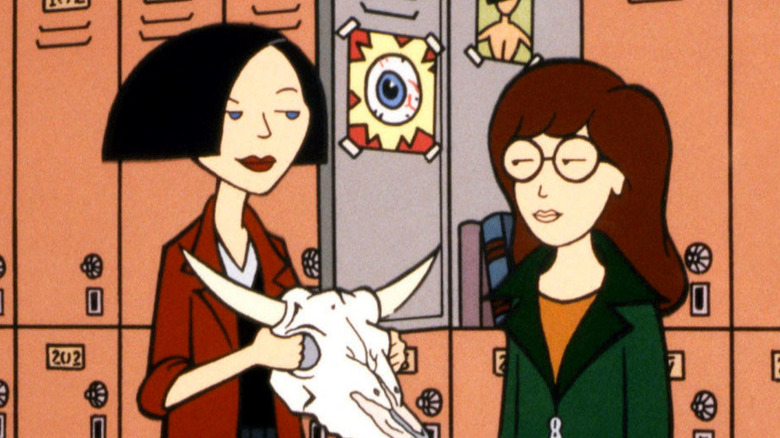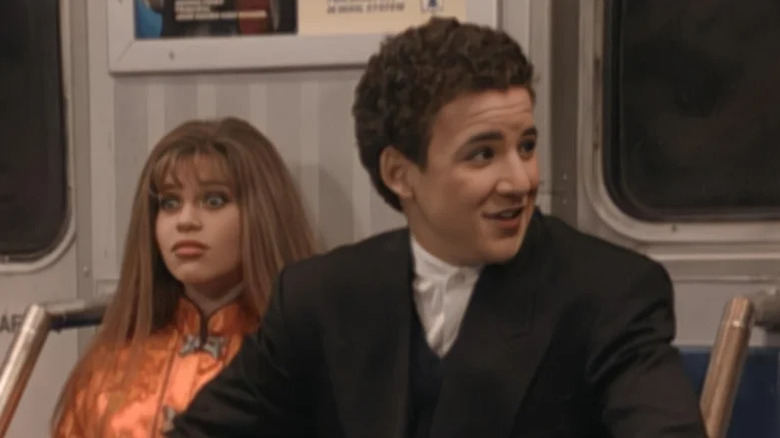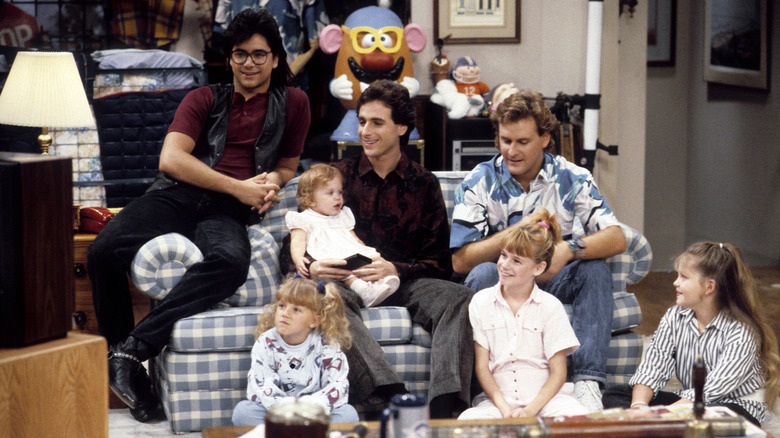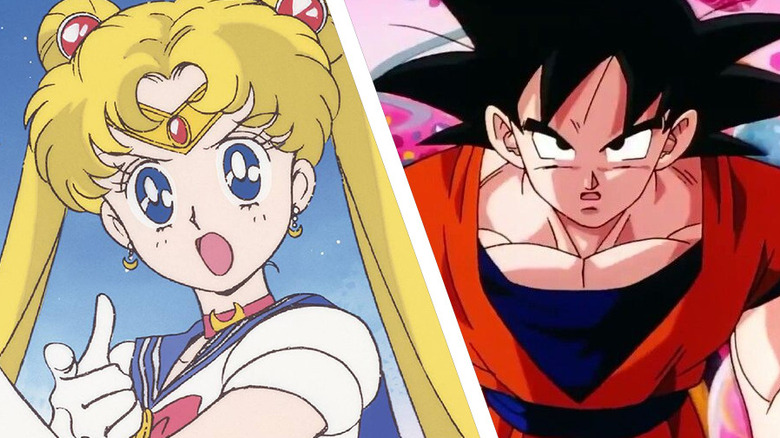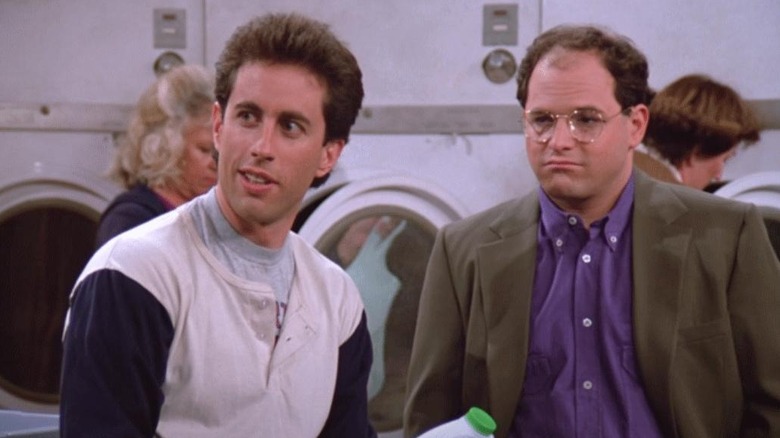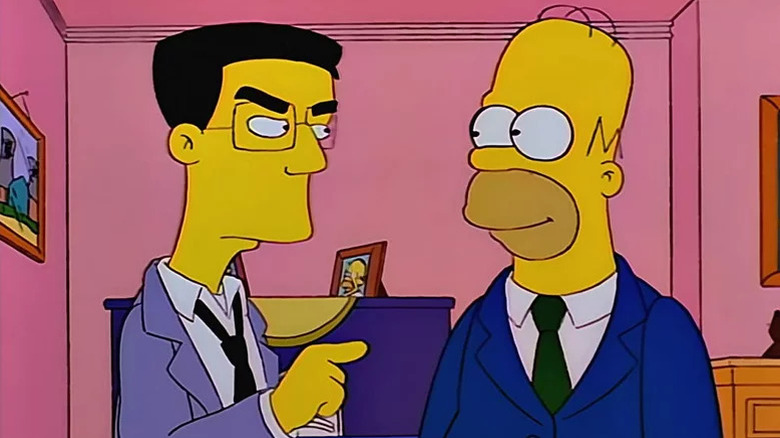The 15 Best TV Shows Of The 1990s
The 1990s dawned a new era in American pop culture: grunge, hip hop, attitude, and a new attention to blue-collar life. The decade that culminated with Y2K was one of acting out, and the media we consumed reflected it. Marginalized groups were making waves in ways the conservatism of the previous decade didn't allow. Teens, Black folks, working class people, women, and gay people rode the wave of neoliberalism that came with Bill Clinton's presidency.
Television reflected this change greatly. Gone were the cookie-cutter sitcoms and family-friendly topics. These shows brought drama, edgier laughs, and took chances in unexpected ways, as well as explored genres previously untapped on the small screen. This boundary-pushing created space for the prestige TV — namely "Sex and the City" and "The Sopranos" — that would end the decade and lead us into the millennium's Golden Age of Television.
Here are the 15 best TV shows of the 1990s.
Buffy the Vampire Slayer
A true sign of icon status is if you can be identified by a singular name. Scully. Mulder. Ross. Rachel. Buffy.
"Buffy the Vampire Slayer" is one of the most beloved fantasy series of all-time. It's been studied academically and referenced by pop culture savants the world over. The show's popularity then and now can be attributed to the humanness the cast brought to the characters despite the often absurd supernatural circumstances of their world. And of course, that realism is anchored by Sarah Michelle Gellar's commitment to making the title character three-dimensional. The actress was helped by creator Joss Whedon's writing, which remains arguably the most poignant of his career. Try to make it through the first seven minutes of "The Body" and feel nothing.
The show's diehard fandom gave rise to a spinoff, "Angel," and now an upcoming sequel series with Sarah Michell Gellar returning. Long live the Buffyverse!
Friends
Few other sitcoms have remained a fixture of the zeitgeist like "Friends." From an iconic cast to memorable storylines, the show remains in the cultural imagination because fans old and new simply can't get enough, and "Friends" has become a comfort watch for the masses. How many people have you heard say they put it on as background noise or to wind down after a stressful day? If you're talking about the best TV from the '90s, you simply can't ignore it. I mean, women were literally going to the hair salon asking for "The Rachel" haircut!
Adding to the argument of "Friends" being peak '90s TV is that the cast has stayed engaged with fans' continued adoration for the show. They speak fondly of their time on the show and have reunited willingly years after the series finale (not to mention grieving the monumental loss of one of their own). Living up to its name, "Friends" was good not only to fans, but to the actors at the center of it.
Living Single
As beloved as "Friends" still is, many fans don't realize the show's premise was significantly influenced by another show with an all-Black cast.
Another entry into the lineage of female-quartet TV shows, "Living Single" is also a comfort watch with reliable laughs. Matching the progressivism of the times, the show featured Black characters in lesser-depicted careers: Maxine Shaw was an attorney, Kyle Barker was a stockbroker, and Khadijah James — brilliantly played by Queen Latifah in her breakout acting role — was a magazine entrepreneur. Particularly for Black audiences, the characters were aspirational but also relatable as they stumbled through relationship troubles. With relentless humor, incredible cast chemistry, and female protagonists as uncompromising as they were vulnerable, "Living Single" was not only popular during its run, but is historically lauded as one of the best sitcoms of all-time.
Ironically, another similarity it has with "Friends" is that, to this point, it has not been rebooted in any way. I suppose when you create perfection the first time around, there's little craving for updated interpretations.
Twin Peaks
If you looked up "cult classic" in the dictionary, you'd undoubtedly find the title card of "Twin Peaks" next to it.
The two-season series, perhaps the best-known work of the late David Lynch, was an experiment of genre. The atmosphere of the fictional Twin Peaks, Washington was dark, mysterious, and humorous all at once. Lynch, a film director, utilized cinematic techniques to bring a greater visual depth to what was happening on screen. The writing of the show saw multiple storylines going at once that weren't always resolved by an episode's end; indeed, the anti-resolution of plotlines added to the sinister feel of the show. In short, "Twin Peaks" was ahead of its time, and ABC's desire to keep the show in a tidy genre box is what led to its cancellation in 1991.
But the ambition of the show aged like a fine wine, and cult fandom brought the show back for a third season in 2017 to rave reviews.
The Fresh Prince of Bel Air
"Now this is a story all about how my life got flip turned upside down...."
If you finished that line in your head, you probably bore witness to one of the funniest sitcoms of the '90s. The brainchild of the late, great Quincy Jones (who thinks the show cemented hip hop in pop culture), "The Fresh Prince of Bel Air" was a vehicle for rapper Will Smith's acting career. From Uncle Phil yeeting Jazz out of the house, to Geoffrey's sarcastic quips, to Will and Carlton's back-and-forth barbs, the show's comedy was unrelenting. "Fresh Prince" was a rare sitcom that appealed to Black and white audiences alike, without sacrificing Black culture in the process. It featured Black slang, fashion, and issues while also depicting a strong Black family unit. The writing didn't always provide the most nuanced conclusions on racism, crime, or class, but it didn't shy away from them when the writing called for it.
"Fresh Prince" also got a refreshingly original reboot. "Bel Air," a dramatic interpretation of the original sitcom, debuted in 2022 and instantly became a massive hit for Peacock. Looking forward to its fourth and final season, fans love the dramatic heft of "Bel Air," as well as the ways it pays tribute to the characters of the original.
Star Trek: The Next Generation
"Star Trek," arguably more than "Star Wars," is a dynasty in science-fiction. It's the grandfather of all space-exploration media that has maintained steady popularity for six decades. "Star Trek: The Next Generation" debuted as the third series in the franchise, and it was actually created in a fit of rage by Gene Roddenberry to capitalize off the popularity of the original series in syndication. The "next generation" of space explorers saw the debut of Patrick Stewart as Jean-Luc Picard, the leader of the Starfleet starship.
This iteration of the series managed to hook viewers in with its great writing, yes, but also the music and acting made for very thrilling sequences. You could really feel the urgency of combating threats to the Enterprise from alien forces. The show mastered the art of rising action to keep viewers engaged and buying into plot developments -– and it did so with fairly primitive CGI.
If the goal for "TNG" was to keep the momentum of the franchise going, it more than succeeded. The next installment, "Deep Space Nine," began before "TNG" even ended in 1994. The series also spawned three films, and most recently the TV series "Star Trek: Picard" on Paramount+.
The X-Files
While alien conspiracy theories are commonplace now, in 1993, the premise of two FBI agents searching to uncover a government plot to hide proof of alien life was a bit strange for a TV show. Yet, "The X-Files" made believers out of audiences everywhere in more ways than one. Brought to life by the chemistry between David Duchovny as Fox Mulder and Gillian Anderson as Dana Scully, "The X-Files" was popular because you didn't have to be a sci-fi buff to enjoy it. It had a little bit of everything: mystery, thriller, humor, romance! Not only that, but paranormal characters that scared adults and kids (undoubtedly watching after bedtime) for years to come.
In the years since it originally left air, fans held on tightly to the series, so much so that Anderson and Duchovny reprised their roles for a tenth season in 2016. They even got an exclusive teaser during Super Bowl 50 (you know, the one where Beyonce upstaged Coldplay). The series ended in 2018 with its eleventh season, but Duchovny is still open to reprising his role in the future. The uniqueness of the concept, as well as the once-in-a-lifetime bond between Mulder and Scully, makes "The X-Files" unrepeatable.
Beverly Hills, 90210
Although there's now a dearth of teen dramas on TV, "Beverly Hills, 90210" started a 25-year revolution with its debut in 1990: the rise of the teen soap TV drama.
The '80s saw a renaissance of teen movies driven by director John Hughes. Buoyed by the success of those films, "Beverly Hills, 90210" premiered in 1990 and soon became a primetime hit. There was a casualness to the interactions between characters on the show that made them feel relatable, even as they dealt with serious issues like date rape, substance abuse, and even AIDS, which was still hugely taboo in the '90s. It gave a grown-up gravity to character dynamics previously unafforded to teens. The popularity of the show led to an influx of other teen and young adult dramas in the '90s like "Clueless," "Dawson's Creek," and sister show "Melrose Place." Years later, the cast reunited for a pseudo-revival that ran for one season in 2019.
It's also interesting to consider how "90210" piqued interest in the lives of upper-middle class white teens. In the 2000s, we saw the premiers of "The OC" and "One Tree Hill," which themselves inspired reality series "Laguna Beach: The Real Orange County" and "The Hills."
Daria
Daria Morgendorffer was sardonic before sardonic was cool. It wasn't a passing feeling to her, it was a way of life. A way of seeing the world. And in calling out hypocrisy, superficiality, sexism, and the obnoxious social dynamics of high school life, she made doing so a little cooler for the rest of us at the time.
"Daria" was popular not only during its original run, but also gained new fans with its run in syndication on The N (now known as Teen Nick) after its finale in 2002. It stands out among its teen television peers because it was a different approach to viewing teen life. If "Beverly Hills, 90210" was Britney Spears, "Daria" was Avril Lavigne. It was the "I'm not like other girls" TV show, the eye-rolling antithesis to teenage melodrama. Though Daria's cynicism often pointed out the absurdity of the world around her, she could also be obnoxiously dismissive and stubborn. Despite her insistence otherwise, Daria was like every other teen: clueless about life and making mistakes in love and friendship, intellect be damned. The irony of this fact is what makes "Daria" a timeless portrayal of teenage personality.
Boy Meets World
If you were a TV kid with ABC Family (now Freeform) in the 2000s, you consumed a healthy diet of "Boy Meets World" (and the next entry on this list). The magic of syndication helped keep the childhood love story of Cory and Topanga in the hearts of millions.
"Boy Meets World" occupied a middle ground with teen shows of the '90s. It wasn't quite as soapy and faux-mature like "90210," and it wasn't edgy and cynical like "Daria." It was wholesome coming-of-age situations with deeper topics peppered in. It addressed social issues like class and abuse with care while allowing its characters to not always arrive at tidy answers to those problems. Admittedly, some of protagonist Cory's behaviors didn't age well (was he really mad at Topanga for wanting to go to her dream school?!). Despite that, the relationships of the show is where it shines. Outside of Cory and Topanga, Cory and Shawn's friendship was a rare example of platonic male intimacy on TV.
We got a reboot in 2014, "Girl Meets World," that portrayed Cory and Topanga's daughter navigating teen life. Even though it was met with mostly positive reviews, "Girl Meets World" was cancelled after three seasons.
Full House
Danny, Michelle, and Uncle Jesse, oh my!
By the end of the show, the Tanner household was so comically full that it was practically overflowing. That absurdity was part of "Full House's" charm. The last gasp of the wholesome American sitcom, you tuned into "Full House" to see Danny Tanner look sincerely into one of his daughter's eyes at the end of an episode with the capital L lesson to be learned. You tuned in for the running bits and catchphrases ("Have mercy!", "You got it dude!", Danny's affinity for cleaning) and what mess the Tanner girls would get into next. The cast, anchored by Bob Saget, Dave Coulier, and John Stamos, each knew their roles and played them with precision. The child actresses were no slouches, either, as Candace Cameron Bure, Jodie Sweetin, and Mary-Kate & Ashley Olsen held their own with seasoned Hollywood actors.
Despite 2016 reboot "Fuller House" receiving mixed reviews throughout its run, the original series remains one of the most beloved family sitcoms of all time.
Batman: The Animated Series
Marvel may dominate the film sphere when it comes to comic adaptations, but long before the Disney Plus, DC was killing it on the small screen, especially with their animated series. "Batman: The Animated Series" was not only the show that gave us Harley Quinn, but also largely responsible for DC's subsequent boom of animated takes on their comic universe. Following this series, DC debuted "Superman: The Animated Series," "The New Batman Adventures," and two "Justice League" shows.
"BTAS" was responsible for revitalizing the source material for Batman and providing a serious adaptation of his universe. It was entertaining to kids without being childlike. It struck a balance the live-action films of the 2010s would come to perfect. Most importantly, to DC faithfuls, "Batman: The Animated Series" is regarded by many as the best superhero TV show of all time. Hard to argue when it featured some of the best versions of well-known characters including Mark Hamill's timeless voice as Joker, Harley Quinn, Poison Ivy, and of course, Batman himself.
Dragon Ball Z and Sailor Moon
Cartoon Network birthed a generation of anime fans with their Toonami block of shows, courtesy of "Dragon Ball Z" and "Sailor Moon." Both series, originally mangas, ran through the mid-'90s in their original Japanese formats. In 1999, the English dubbed versions debuted on Toonami, a late-night block of action-oriented shows on Cartoon Network. While Toonami has been cancelled and revived over the years, the height of its popularity and influence was in the early 2000s with its slate of anime series. "DBZ" and "Sailor Moon" are the two that have stood the test of time.
The intense fight scenes and lore of "DBZ" is what made it ultra-cool to viewers, whereas the "girl power" and sisterhood aspects of "Sailor Moon" is what made it endearing to audiences. It's difficult to convey just how loved these two franchises are, but if their vast universes of manga, films, sagas, and reboots are any indication, they stand head and shoulders above most '90s shows.
They are the best of the '90s because of their crucial role in popularizing anime in the United States. Soon after their success on Toonami, there was a boom of American shows biting the animation style, colloquially referred to as "hamburger anime." There is no "Totally Spies," the original "Teen Titans," or "Avatar: The Last Airbender" without the diehard fandom of "Sailor Moon" and "DBZ."
Seinfeld
"Seinfeld" scratched a certain itch with American audiences. During a decade of social change, emerging taboos, and at times civil unrest, people craved sitting with the mundanity of life, if only for 30 minutes at a time.
Though marketed as such for years, "Seinfeld" actually wasn't a "show about nothing" but rather a show about how comedian Jerry Seinfeld -– the real one and the character -– got material for his comedy. Those familiar with the comedy world will tell you that the richest jokes come from keen observation skills, finding the absurdity in the everyday. That's exactly what "Seinfeld" succeeded in doing during its run, which essentially spanned the entire 1990s.
Outside of cementing Jerry Seinfeld's legacy as a comedian, it also jumpstarted the Hollywood careers of two other legends: Larry David, who co-wrote the series with Seinfeld, and Julia Louis-Dreyfus, who starred in the series as Seinfeld's ex-girlfriend, Elaine. Their excellent work on "Seinfeld" led them to starring roles in their own series, "Curb Your Enthusiasm" for David and "Veep" for Louis-Dreyfus, respectively. In an ironic way, "Seinfeld" helped all involved sharpen the comedic chops that would carry them far beyond the show's final episode.
The Simpsons
"The Simpsons" transcends time and space. The only show on this list still going in its original form, it has become a certainty in life alongside death and taxes (or tariffs, I guess).
Starting in 1989, the first decade of the show's existence has many of its best episodes, including parodies of iconic movie and TV moments such as "A Streetcar Named Desire," "The Natural," and funnily enough "The X-Files." These kinds of episodes were par for the course in the series; though on the surface a primitive comedy because of its dimwitted protagonist, Homer, the show masterfully addressed class, gender, and race relations in the U.S. It also poked fun at the absurdity of our political system. Obviously, their conclusions on these issues were imperfect, but the way they were weaved into the show were provocative for the time. Arguably, "The Simpsons" pioneered this approach to adult animation.
In the end, what keeps "The Simpsons" on air is the imperfectly loving dynamics of this working class family. Who knows, without "The Simpsons," perhaps we never get other beloved animated family series like "Family Guy," "American Dad," or even "Bob's Burgers."
